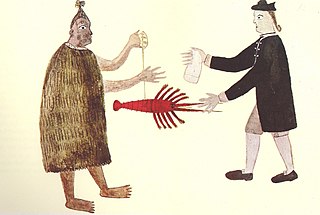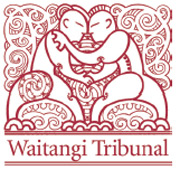
The Treaty of Waitangi, sometimes referred to as Te Tiriti, is a document of central importance to the history of New Zealand, its constitution, and its national mythos. It has played a major role in the treatment of the Māori people in New Zealand by successive governments and the wider population, something that has been especially prominent from the late 20th century. The treaty document is an agreement, not a treaty as recognised in international law. It was first signed on 6 February 1840 by Captain William Hobson as consul for the British Crown and by Māori chiefs from the North Island of New Zealand. The treaty's quasi-legal status satisfies the demands of biculturalism in contemporary New Zealand society. In general terms, it is interpreted today as having established a partnership between equals in a way the Crown likely did not intend it to in 1840. Specifically, the treaty is seen, first, as entitling Māori to enjoyment of land and of natural resources and, if that right were ever breached, to restitution. Second, the treaty's quasi-legal status has clouded the question of whether Māori had ceded sovereignty to the Crown in 1840, and if so, whether such sovereignty remains intact.
Taonga or taoka is a Māori-language word that refers to a treasured possession in Māori culture. It lacks a direct translation into English, making its use in the Treaty of Waitangi significant. The current definition differs from the historical one, noted by Hongi Hika as "property procured by the spear" [one could understand this as war booty or defended property] and is now interpreted to mean a wide range of both tangible and intangible possessions, especially items of historical cultural significance.

Robin Brunskill Cooke, Baron Cooke of Thorndon, was a New Zealand judge and later a British Law Lord and member of the Judicial Committee of the Privy Council. He is widely considered one of New Zealand's most influential jurists, and is the only New Zealand judge to have sat in the House of Lords. He was a Non-Permanent Judge of the Court of Final Appeal of Hong Kong from 1997 to 2006.

The Waitangi Tribunal is a New Zealand permanent commission of inquiry established under the Treaty of Waitangi Act 1975. It is charged with investigating and making recommendations on claims brought by Māori relating to actions or omissions of the Crown, in the period largely since 1840, that breach the promises made in the Treaty of Waitangi. The Tribunal is not a court of law; therefore, the Tribunal's recommendations and findings are not binding on the Crown. They are sometimes not acted on, for instance in the foreshore and seabed dispute.
The New Zealand foreshore and seabed controversy is a debate in the politics of New Zealand. It concerns the ownership of the country's foreshore and seabed, with many Māori groups claiming that Māori have a rightful claim to title. These claims are based around historical possession and the Treaty of Waitangi. On 18 November 2004, the New Zealand Parliament passed a law which deems the title to be held by the Crown. This law, the Foreshore and Seabed Act 2004, was enacted on 24 November 2004. Some sections of the act came into force on 17 January 2005. It was repealed and replaced by the Marine and Coastal Area Act 2011.

The constitution of New Zealand is the sum of laws and principles that determine the political governance of New Zealand. Unlike many other nations, New Zealand has no single constitutional document. It is an uncodified constitution, sometimes referred to as an "unwritten constitution", although the New Zealand constitution is in fact an amalgamation of written and unwritten sources. The Constitution Act 1986 has a central role, alongside a collection of other statutes, orders in Council, letters patent, decisions of the courts, principles of the Treaty of Waitangi, and unwritten traditions and conventions. There is no technical difference between ordinary statutes and law considered "constitutional law"; no law is accorded higher status. In most cases the New Zealand Parliament can perform "constitutional reform" simply by passing acts of Parliament, and thus has the power to change or abolish elements of the constitution. There are some exceptions to this though – the Electoral Act 1993 requires certain provisions can only be amended following a referendum.
Claims and settlements under the Treaty of Waitangi have been a significant feature of New Zealand politics since the Treaty of Waitangi Act 1975 and the Waitangi Tribunal that was established by that act to hear claims. Successive governments have increasingly provided formal legal and political opportunity for Māori to seek redress for what are seen as breaches by the Crown of guarantees set out in the Treaty of Waitangi. While it has resulted in putting to rest a number of significant longstanding grievances, the process has been subject to criticisms including those who believe that the redress is insufficient to compensate for Māori losses. The settlements are typically seen as part of a broader Māori Renaissance.
The Treaty of Waitangi Act 1975 gave the Treaty of Waitangi recognition in New Zealand law for the first time and established the Waitangi Tribunal. The tribunal was empowered to investigate possible breaches of the principles of the Treaty of Waitangi by the New Zealand Government or any state-controlled body, occurring after 1975. It was also empowered to recommend, but not enforce, remedies.

Aboriginal title is a common law doctrine that the land rights of indigenous peoples to customary tenure persist after the assumption of sovereignty to that land by another colonising state. The requirements of proof for the recognition of aboriginal title, the content of aboriginal title, the methods of extinguishing aboriginal title, and the availability of compensation in the case of extinguishment vary significantly by jurisdiction. Nearly all jurisdictions are in agreement that aboriginal title is inalienable, and that it may be held either individually or collectively.
The Māori protest movement is a broad indigenous rights movement in New Zealand. While there was a range of conflicts between Māori and European immigrants prior to the signing of the Treaty of Waitangi in 1840, the signing provided one reason for protesting. Disagreements in the decades following the signing sometimes included war.
The law of New Zealand uses the English common law system, inherited from being a part of the British Empire.

The New Zealand land confiscations took place during the 1860s to punish the Kīngitanga movement for attempting to set up an alternative Māori form of government that forbade the selling of land to European settlers. The confiscation law targeted Kīngitanga Māori against whom the government had waged war to restore the rule of British law. More than 1,200,000 hectares or 4.4 percent of land were confiscated, mainly in Waikato, Taranaki and the Bay of Plenty, but also in South Auckland, Hauraki, Te Urewera, Hawke's Bay and the East Coast.
The Marine and Coastal Area Act 2011 is an Act of the New Zealand Parliament created to replace the Foreshore and Seabed Act 2004. It was brought in by the fifth National government and creates a sui generis property class for the marine and coastal area, in which it is vested in no one. This is in contrast to the Foreshore and Seabed Act 2004 in which the foreshore and seabed were vested in the Crown.

The Ngāi Tahu Claims Settlement Act 1998 is an act of Parliament passed in New Zealand relating to Ngāi Tahu, the principal Māori iwi (tribe) of Te Waipounamu the South Island. It was negotiated in part by Henare Rakiihia Tau. The documents in relation to the Ngāi Tahu land settlement claim are held at Tūranga, the main public library in Ōtautahi Christchurch.
The New Zealand Māori Council is a body that represents and consults the Māori people of New Zealand. As one of the oldest Māori representative groups, the council exerts pressure on New Zealand governments to protect Treaty of Waitangi rights.

The judiciary of New Zealand is responsible for the system of courts that interprets and applies the laws of New Zealand. It has four primary functions: to provide a mechanism for dispute resolution; to deliver authoritative rulings on the meaning and application of legislation; to develop case law; and to uphold the rule of law, personal liberty and human rights. The judiciary is supported in its work by an executive department, the Ministry of Justice.

The principles of the Treaty of Waitangi is a set of principles derived from, and interpreting, the Treaty of Waitangi, which was signed in New Zealand in 1840. The phrase "principles of the Treaty of Waitangi" was first used in the Treaty of Waitangi Act 1975, and the principles were codified in 1987. There is no final list and they are determined on a case-by-case basis. They include the three Ps: partnership, participation and protection of rangatiratanga.

R v Symonds(The Queen v Symonds) was an 1847 New Zealand Supreme Court case that incorporated the concept of aboriginal title into New Zealand law and upheld the government's pre-emptive right of purchase to Māori land deriving from the common law and expressed in the Treaty of Waitangi.

In Re the Ninety-Mile Beach was a decision of the Court of Appeal of New Zealand holding that Maori could not hold title to the foreshore because of the effect of section 147 of the Harbours Act 1878 ; and because investigation of title to land adjacent to the sea by the Māori Land Court had extinguished rights to land below the high water mark. The decision was overturned in 2003 by Ngati Apa v Attorney-General.

Ngāti Whātua o Kaipara is a Māori iwi (tribe) and hapū (sub-tribe) of New Zealand, which is part of the larger Ngāti Whātua iwi. The iwi's rohe is focused around the southern Kaipara Harbour in the Auckland Region of New Zealand. Ngāti Whātua have been present in the Kaipara Harbour since the arrival of the Māhuhu-ki-te-rangi migratory waka, gradually moving towards the north. By the 17th century, Ngāti Whātua reestablished a presence in the southern Kaipara Harbour.









